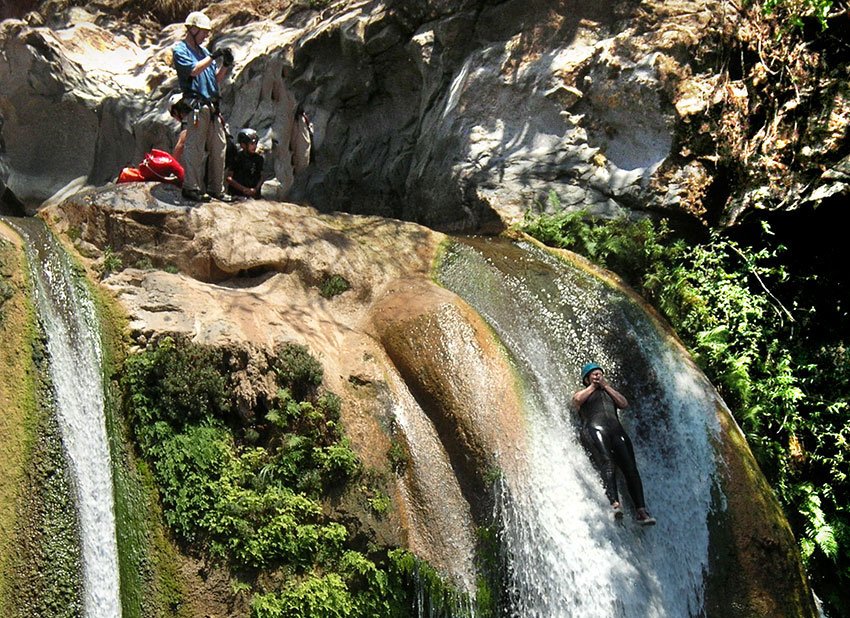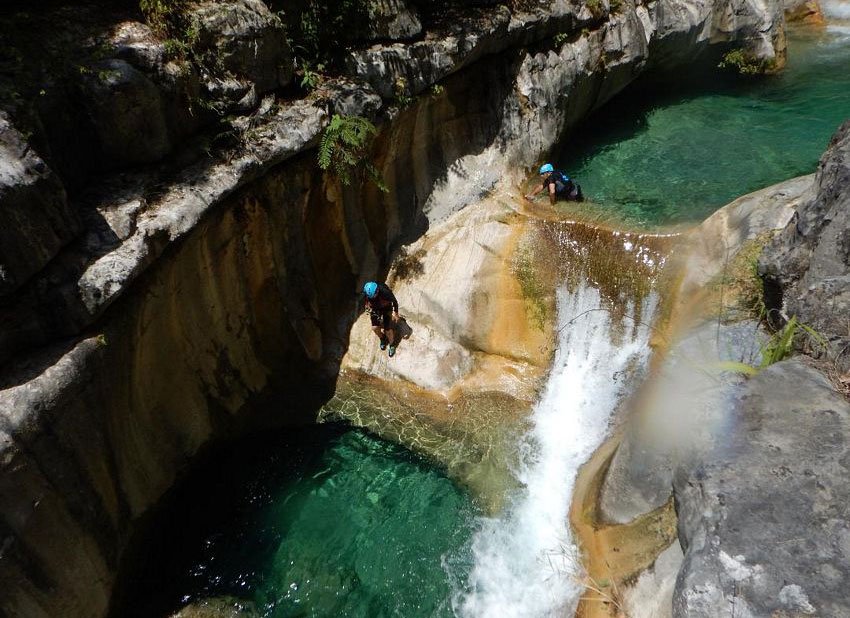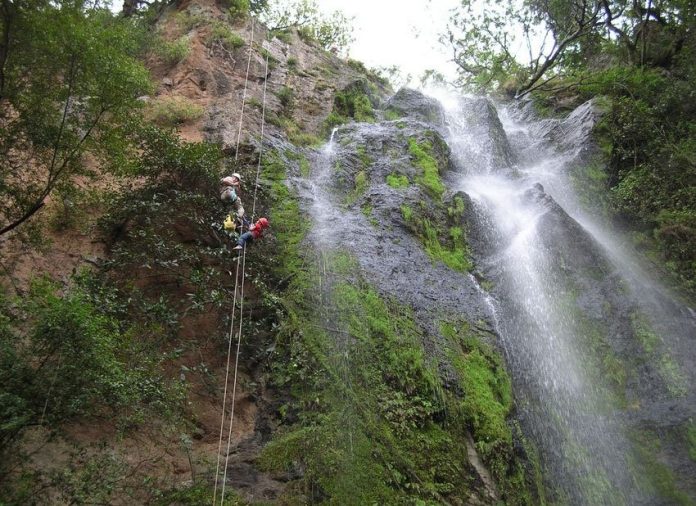Canyoning — known as canyoneering in theUnited States — is a sport which involves rappelling down cascades, lots of hiking and plunging into cold pools of water in order to follow a river down a canyon. It is practiced all over the world wherever river canyons are found.
The exploration of canyons is probably as old as the human race itself, but the modern sport of canyoning seems to have got its start in 1905 when Edouard Martel, “the father of modern speleology,” conducted a hair-raising hiking and rafting expedition down France’s Gorges du Verdon, the largest canyon in Europe.
Canyoneers are typically exposed to very cold temperatures and have to wear wet suits as they slide or jump down waterfalls, plunge into pools and then swim for their lives. When I first heard about this sport from my caving friends, I honestly thought that canyoneers must have a screw loose somewhere.
“What’s the point of rappelling,” I asked them, “if there’s not something important at the bottom of your rope . . . like a cave?”
When I asked Luis Medina, an experienced canyoneer who has represented Mexico in international canyoning events, what it is that he finds so attractive about canyoning, I was surprised by his reply.

“I was a climber,” said Medina. “In 1998 I started climbing and I loved it. I could easily have spent 24 hours a day doing nothing but climbing. It became my passion, my religion, my everything!
“Well, I was doing a lot of rock climbing in Huaxtla canyon, just north of Guadalajara and because it was really hot there, I would cool off in the waterfall. So I was alternating between climbing and canyoning and little by little, my friends and I started doing more and more canyoning.
“Actually, canyoning is more fun than climbing because you are jumping, swimming, hiking, discovering new places, exploring, and you have more chance of seeing wild animals. So now I see climbing as more oriented toward technique and canyoning more toward nature.”
Medina told me that the very best place for canyoning in Mexico is the area around the city of Monterrey. “In this area,” he said, “you have Cumbres de Monterrey, Matacanes, Chipitín, Hidrofobia and La Garganta del Diablo (The Devil’s Throat), all of them with very high walls, limestone rock and big waterfalls. There are also great places in Tabasco, Veracruz, Hidalgo and all around Mexico City.
“As for Jalisco, we have beautiful, but rather short canyons like Aquetzalli, Huaxtla, Los Azules and the Sierra de Quila.”
Although I really prefer to stay high and dry on weekends, I found Luis Medina’s rationale for canyoning intriguing, so my ears perked up when my friend Rodrigo Orozco told me: “I’m going to abseil down a waterfall tomorrow. It’s located in a place so beautiful that I want to be buried there someday.”

Now that got my attention, but when Rodrigo mentioned that he hates to get wet while canyoning, I really became interested. “I always put my rope as far from the falling water as possible,” he told me.
I was sold. “Dry canyoning? That’s for me!” I told him.
The next day I set off with Rodrigo Orozco and another canyoneer, Chris Lloyd, whose daughters, aged 9 and 7, were planning to do the rappel.
“If they can do it,” I said, “so can I.”
Off we drove to the spot where our 90-minute hike would begin. Remember that part about canyoning often including more hiking than rappelling? Well, in this case the landscape we passed through was so varied and beautiful, I soon forgot all about the waterfall jump. It was October and wildflowers were blooming everywhere. We were simply dazzled by the variety and profusion of all we saw.
Add to this the amazing talent of “Tarantula Man” Rodrigo for finding curious creatures every time he overturns a stone, and you have the recipe for a marvelous outing. Frogs, spiders, scorpions, brightly colored butterflies and, of course tarantulas, seemed to be lurking everywhere. So was plenty of mud and several streams we had to cross.

At last we reached our goal, which Rodrigo instructed me to refer to as “Nameless Falls,” as he would prefer to keep the place secret. My friends then attached a rope to a convenient tree, supposedly in a spot well away from the cascade. This, however, I couldn’t determine, since it was just about impossible to see anything directly beneath us.
“John, why don’t you go first?” said Rodrigo.
“OK, if you’re sure the rope reaches all the way to the bottom.”
“I hope so,” came the less-than-comforting reply.
I am a caver and I can assure you that leaning backward over the edge of a black, gaping cave entrance is a lot easier than doing the same out in the blue, where you can actually see the tops of trees far below you, giving your brain plenty of time to calculate the distance and imagine what will become of your body if something goes wrong.
This may be why some people never get beyond the first lesson in Rappelling 101 which, of course, includes standing at the edge of a cliff, connected to the rope by your rappelling device, leaning back and jumping. For some people, terror sets in during the leaning-back part, just at the moment they look down, and nothing on earth can get them to actually go ahead and jump, thus putting a quick end to their rappelling career.
[soliloquy id="81376"]
In my case, being the first to jump turned out to have a big advantage: a favorable breeze blew the spray from the waterfall away from me and I had a very pleasant and dry slide down the rope.
At last, from the bottom, I could see the waterfall in all its glory. It was about 60 meters high and much wider than the little river up on the top. There was a nice pool at its foot which would be inviting in the summer but I was happy to be wearing a jacket on this autumn day.
As my companions descended, each one got a little wetter than the previous because the spray had started to blow towards the rope. This meant that the last one over the edge, little Meli Lloyd (who came down with Rodrigo Orozco on parallel ropes), ended up soaked to the skin. To raise our body temperatures, we quickly began hiking up a very steep trail back to the head of the waterfall.
At last I could call myself a canyoneer of sorts, but I think it will be a long time before I forget little Meli’s final assessment of this sport, made as she stood soaked to the skin at the foot of the falls.
“What was it like, Meli?” we asked her.
Shivering, she looked up at us from under the helmet she was still wearing: “C-c-cold and w-w-wet,” she said through chattering teeth, and I will add no further comment.
Along with the thrills of canyoning come plenty of dangers. Flash floods, hypothermia and falling to your death are just a few to be considered. So, this extreme sport should only be practiced in the company of true experts using proper gear. Check out the canyoning excursions offered in the Monterrey area by Bakpak, Revista de Aventura.
The writer has lived near Guadalajara, Jalisco, for more than 30 years and is the author of A Guide to West Mexico’s Guachimontones and Surrounding Area and co-author of Outdoors in Western Mexico. More of his writing can be found on his website.
